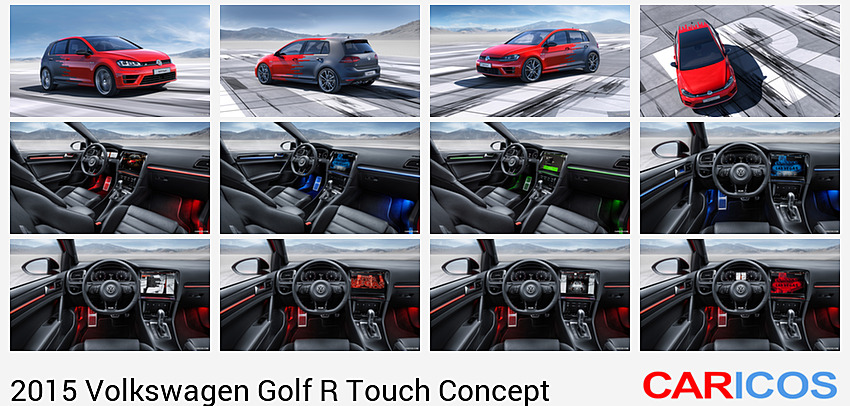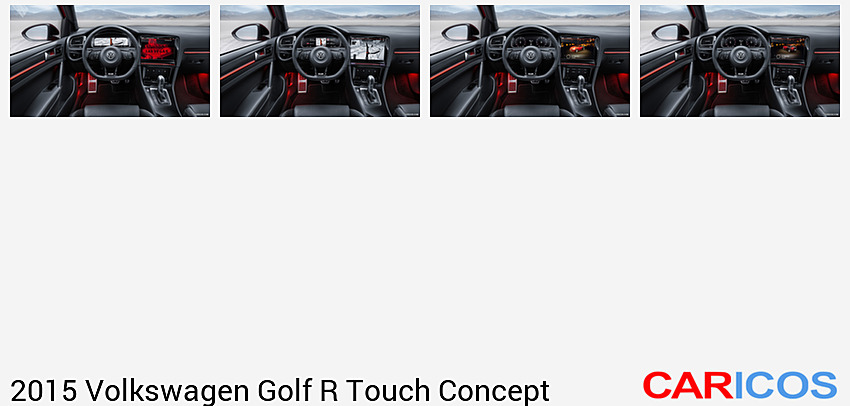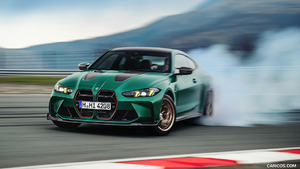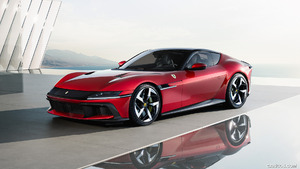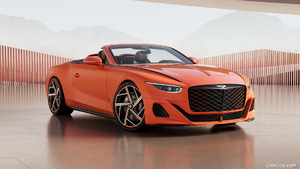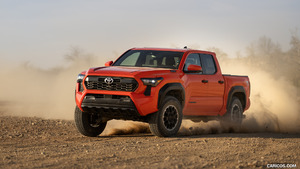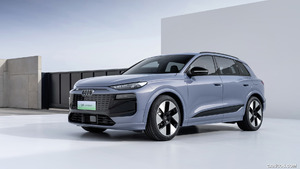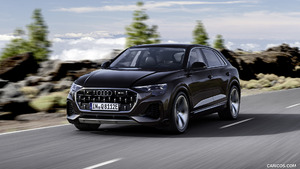In Las Vegas, Volkswagen is presenting the first compact vehicle with gesture control that is fully equipped with the controls of tomorrow. In this car, the high-performance of its computer, the brilliance of today's displays and the recognition of precise human gestures are merging into an entirely new interface generation. A simple hand motion in the space in front of the central infotainment display of the Golf to make human and machine interact as one via gesture control. Following a consistent strategy, Volkswagen is thereby extending its concept of intuitive control beyond the level of the touchscreen and into the third dimension. The fact that it is Volkswagen that is attaining this new level of control is anything but a coincidence. It is the logical conclusion of an intelligent strategy.
Volkswagen operating philosophy
Intuitive operation. Volkswagen has always striven for clearly organized controls and information that are intuitive. No less applies to the future of interfaces. At the end of the past century, it was already evident that the density of information in the car would grow exponentially. In this context, a comprehensive user operation strategy had to be developed, which would not overload the driver in the future. Even more, the operating systems of tomorrow should enable more fun than ever from media libraries, facts, news and communication in the automobile. Those were the requirements for the future. Operation of even highly complex infotainment devices and their menus would therefore have to be clearly organized and remain easy to understand while still projecting an extremely high quality image. To achieve this goal, Volkswagen brought together an interdisciplinary team of designers, ergonomics specialists and electronics specialists. They developed systems with direct interaction. Consequently, Volkswagen has preferred the touchscreen for years now; indirect controls are not found in a Volkswagen. As a result, the brand has long been an industry model in terms of its user interfaces. And it will remain so in the future, as Volkswagen is demonstrating with the Golf R Touch at the 2015 CES in Las Vegas
Switch-free operation. The development team for the Golf R Touch pursued the goal of developing an interior and infotainment concept that would fulfill seemingly contradictory requirements. Despite continually growing complexity and numbers of functions, this concept was intended to reduce driver distractions while attaining a maximum of personalization and intuitive operation in the car. A vehicle was created in which nearly all controls are implemented via touchscreens and touchpads – a nearly switch-free cockpit. The Golf R Touch is equipped with three displays: the 12.8-inch touchscreen of the infotainment system (resolution: 2,560 x 1,700 pixels), a Control Center (8.0-inch with touch feedback) located beneath it for vehicle, climate control and media functions (resolution: 800 x 480 pixels) and an Active Info Display (digitalized instruments) in 12.3-inch format (resolution: 1,920 x 720 pixels).
A highlight in the Golf R Touch is its new controls. Take the roof module, for example: when a hand approaches, it shows a symbol on the screen like magic. When the user touches its surface, a related menu is shown simultaneously on the 12.8-inch touchscreen of the infotainment system with various settings such as "open/close the sunroof". The key aspect is that important roof functions can now be directly accessed and controlled by a gesture in the space in front of the control panel. For instance, a swiping motion towards the windshield is used to close the sunroof, while a swiping motion away from the windshield opens it. Seat adjustment operates equally intelligently. As soon as a person's hand moves laterally at the driver's seat or front passenger's seat, the proximity detection system for the seat controls recognizes this. On the large touchscreen, helpful tips and information on user control are now displayed. Naturally, the seats can be fully controlled via touchscreen.
Infotainment system – touchscreen with gesture control
Controls include touch slider. As mentioned, gesture control is integrated into the operation of the 12.8-inch touchscreen on the center console. And Volkswagen is also calling the technology being presented in Las Vegas "gesture control". In addition, the system has high-resolution proximity sensors. A similar form of these sensors is already being used in the Golf and other models today. Beneath the infotainment display there is a touch slider; in the Golf R Touch it replaces the classic rotary knob control. The slider, which is equipped with a guide rail for the finger plus LED illumination and proximity sensors, is used to intuitively and precisely adjust such settings as the volume of the sound system. Ingenious: the slider can recognize the number of fingers being used. When one finger is used, the audio volume is controlled; with two fingers the navigation volume, and with three fingers the telephone volume. In addition, the color scheme of the ambient lighting and the infotainment unit, bass and treble adjustment and balance and fader are also set by slider.
Look and feel of the touchscreen. More than ever, the screen of the infotainment system is becoming the central control point of the cockpit. The clean integration of the display in the center console has an extremely high-end look. Contributing to this high-end look is the fact that there are hardly any real pushbuttons. This gives the center console a decidedly clean and well organized appearance. Thanks to the proximity sensors, there is also a very clear information mode and an intuitive operating mode with optimally sized controls. The information density is controlled intelligently via the proximity sensors; in addition, the innovative gesture control is used to activate and operate other menu levels at lightning speed.
Gesture control of the touchscreen. 3D control of gestures in the space is made possible by a 3D camera mounted in the roof module. This makes user operation easier than ever. A person logs onto the system by spreading the fingers of a hand. This prevents unintentional activation of a function with a hand movement. A control is selected using the index finger – moving it in the air, of course. A function is confirmed by a virtual button push with the index finger. The gesture input is ended by closing the fingers of the hand.
Personalization of the touchscreen. The display itself can be comprehensively personalized. As is familiar on smartphones and tablets, for instance, photos or graphics may be integrated as backgrounds in an instant, and various windows with contents such as "weather" or "media library" (also graphically personalized) are laid out on the screen. The individual window tiles can be moved or changed in size by touch. If a navigation map is active in background, for instance, it automatically adapts to the new layout. The car itself can also be represented in 3D (interior or exterior, open or closed, lights on or off, windows open or closed), and it can be rotated by touch and gestures. The Information menu provides the live status of the vehicle and if necessary explanatory animations.
Personalized ambient lighting. Last but not least, the dominant color of the display lighting – what is known as the HMI decor color – and similarly the ambient lighting can be adjusted via the touch slider. Also embedded in this color staging is opening/start-up and parking/closing of the Golf R Touch: When the car is opened, the interior comes to life with the entire cockpit and ambient lighting; when the car is parked it goes into the standby mode. The ambient lighting has a color depth of 24 bits; this enables representation of 16.7 million colors.
Instruments – Active Info Display
Instruments that can be personalized. Similar to the touch display of the infotainment system, the home screen of the 12.3-inch Active Info Display can also be individually adapted, because all of the instruments and indicators are generated digitally. Internally, the developers distinguish between the "small stage" and the "large stage". Depending on the configuration, the "small stage" might contain the tachometer on the left (with gear indicator in middle and engine temperature at bottom), a digitally-generated analog speedometer on the right (with digital indicator in middle and fuel gage at bottom) and between them the multifunction display with all conceivable menus such as traffic messages or navigation instructions. Always displayed below this and unmovable are the odometer/trip odometer and the clock. On the "large stage", the multifunction display handles such tasks as map display for the navigation system. On the left, instead of the tachometer, the display might show messages about traffic or info from the onboard computer (such as fuel economy and engine temperature). On the right, instead of the speedometer there might be a cover (with artist and song) from the media library as well as the date and outdoor temperature. Unchangeable in this case are the gear indicator at the lower left and the vehicle speed plus fuel gage at the lower right.
Center console – Control Center
Fantastic. Located beneath the 12.8-inch main screen is the 8.0-inch Control Center for climate control, media library and vehicle functions. While hard keys are generally used to control vehicle and climate control functions, in the case of the Control Center touchpads are used. They give touch feedback via special actuators. Absolute innovation: the transitions from one touch button on the touch display to another button can now truly be felt. Using a special sensor, the Control Center can even measure the force of the user's control action. This permits functions that are activated via a pressure point just like with mechanical buttons. These refined details show how mature the overall concept is. In a Volkswagen, the controls on touch displays that lie far outside of the driver's peripheral field of vision can be felt by touch. And this reduces distractions to the driver significantly.
Front seats have bass shakers. The music aboard the Golf R Touch can also be experienced on a very elemental level. What are referred to as bass shakers – integrated in the driver and front passenger seats – make the sound waves quite noticeable. The music of the sound system is experienced more intensively on a physical level in addition to perception by the ears.
Race staging
Electronics emphasize sportiness. The "Golf R Touch" is equipped with the 292-PS USA-engine of the new Golf R. Of course, any other drive system could be installed in this Golf as well. However, since the new R engine serves as the proxy here, and the car was dynamically configured accordingly, a special "race staging" function is also provided. It is activated via the large 12.8-inch touchscreen, and it simulates a wide variety of parameters – creating a sort of test drive while stationary. The engine sound is played back over the loudspeakers of the sound system during acceleration, images of the drive itself are projected on the touchscreen, all relevant vehicle data are shown in the Active Info Display; the car boosts chassis vibrations by seat actuators, and finally the lighting is modified in the interior. Race staging illustrates how more parameters can be personalized and electronically simulated than ever before.

